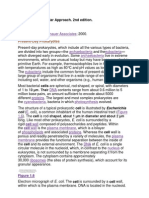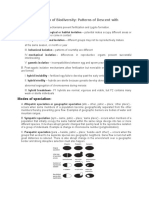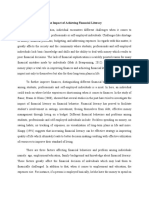The Primary Kingdoms
The Primary Kingdoms
Uploaded by
EzgamApeCopyright:
Available Formats
The Primary Kingdoms
The Primary Kingdoms
Uploaded by
EzgamApeOriginal Description:
Original Title
Copyright
Available Formats
Share this document
Did you find this document useful?
Is this content inappropriate?
Copyright:
Available Formats
The Primary Kingdoms
The Primary Kingdoms
Uploaded by
EzgamApeCopyright:
Available Formats
Proc. Natl. Acad. Sci. USA Vol. 74, No. 11, pp.
5088-5090, November 1977 Evolution
Phylogenetic structure of the prokaryotic domain: The primary kingdoms
(archaebacteria/eubacteria/urkaryote/16S ribosomal RNA/molecular phylogeny)
CARL R. WOESE AND GEORGE E. Fox*
Department of Genetics and Development, University of Illinois, Urbana, Illinois 61801
Communicated by T. M. Sonneborn, August 18,1977
A phylogenetic analysis based upon ribosomal ABSTRACT RNA sequence characterization reveals that living systems represent one of three aboriginal lines of descent: (i) the eubacteria, comprising all typical bacteria; (ii) the archaebacteria, containing methanogenic bacteria; and (iii) the urkaryotes, now represented in the cytoplasmic component of eukaryotic cells.
The biologist has customarily structured his world in terms of certain basic dichotomies. Classically, what was not plant was animal. The discovery that bacteria, which initially had been considered plants, resembled both plants and animals less than plants and animals resembled one another led to a reformulation of the issue in terms of a yet more basic dichotomy, that of eukaryote versus prokaryote. The striking differences between eukaryotic and prokaryotic cells have now been documented in endless molecular detail. As a result, it is generally taken for granted that all extant life must be of these two basic types. Thus, it appears that the biologist has solved the problem of the primary phylogenetic groupings. However, this is not the case. Dividing the living world into Prokaryotae and Eukaryotae has served, if anything, to obscure the problem of what extant groupings represent the various primeval branches from the common line of descent. The reason is that eukaryote/ prokaryote is not primarily a phylogenetic distinction, although it is generally treated so. The eukaryotic cell is organized in a different and more complex way than is the prokaryote; this probably reflects the former's composite origin as a symbiotic collection of various simpler organisms (1-5). However striking, these organizational dissimilarities do not guarantee that eukaryote and prokaryote represent phylogenetic extremes. The eukaryotic cell per se cannot be directly compared to the prokaryote. The composite nature of the eukaryotic cell makes it necessary that it first be conceptually reduced to its phylogenetically separate components, which arose from ancestors that were noncomposite and so individually are comparable to prokaryotes. In other words, the question of the primary phylogenetic groupings must be formulated solely in terms of relationships among "prokaryotes"-i.e., noncomposite entities. (Note that in this context there is no suggestion a priori that the living world is structured in a dichotomous way.) The organizational differences between prokaryote and eukaryote and the composite nature of the latter indicate an important property of the evolutionary process: Evolution seems to progress in a "quantized" fashion. One level or domain of organization gives rise ultimately to a higher (more complex) one. What "prokaryote" and "eukaryote" actually represent are two such domains. Thus, although it is useful to define phylogenetic patterns within each domain, it is not meaningful
The costs of publication of this article were defrayed in part by the payment of page charges. This article must therefore be hereby marked "advertisement" in accordance with 18 U. S. C. 1734 solely to indicate this fact.
to construct phylogenetic classifications between domains: Prokaryotic kingdoms are not comparable to eukaryotic ones. This should be recognized by, an appropriate terminology. The highest phylogenetic unit in the prokaryotic domain we think should be called an "urkingdom"-or perhaps "primary kingdom." This would recognize the qualitative distinction between prokaryotic and eukaryotic kingdoms and emphasize that the former have primary evolutionary status. The passage from one domain to a higher one then becomes a central problem. Initially one would like to know whether this is a frequent or a rare (unique) evolutionary event. It is traditionally assumed-without evidence-that the eukaryotic domain has arisen but once; all extant eukaryotes stem from a common ancestor, itself eukaryotic (2). A similar prejudice holds for the prokaryotic domain (2). [We elsewhere argue (6) that a hypothetical domain of lower complexity, that of "progenotes," may have preceded and given rise to the prokaryotes.] The present communication is a discussion of recent findings that relate to the urkingdom structure of the prokaryotic domain and the question of its unique as opposed to multiple origin. Phylogenetic relationships cannot be reliably established in terms of noncomparable properties (7). A comparative approach that can measure degree of difference in comparable structures is required. An organism's genome seems to be the ultimate record of its evolutionary history (8). Thus, comparative analysis of molecular sequences has become a powerful approach to determining evolutionary relationships (9, 10). To determine relationships covering the entire spectrum of extant living systems, one optimally needs a molecule of appropriately broad distribution. None of the readily characterized proteins fits this requirement. However, ribosomal RNA does. It is a component of all self-replicating systems; it is readily isolated; and its sequence changes but slowly with time-permitting the detection of relatedness among very distant species (11-13). To date, the primary structure of the 16S (18S) ribosomal RNA has been characterized in a moderately large and varied collection of organisms and organelles, and the general phylogenetic structure of the prokaryotic domain is beginning to emerge. A comparative analysis of these data, summarized in Table 1, shows that the organisms clearly cluster into several primary kingdoms. The first of these contains all of the typical bacteria so far characterized, including the genera Acetobacterium, Acinetobacter, Acholeplasma, Aeromonas, Alcaligenes, Anacystis, Aphanocapsa, Bacillus, Bdellovbrio, Chlorobium,
Chromatium, Clostridium, Corynebacterium, Escherichia, Eubacterium, Lactobacillus, Leptospira, Micrococcus, Mycoplasna, Paracoccus, Photobacteriurn, Propionibacterium,
Present address: Department of Biophysical Sciences, University of Houston, Houston, TX 77004.
5088
Evolution: Woese and Fox
1
Proc. Natl. Acad. Sci. USA 74 (1977)
5089
Table 1. Association coefficients (SAB) between representative members of the three primary kingdoms 2
10
11
12
13
1. Saccharomyces cerevisiae, 18S 2. Lemna minor, 18S 3. L cell, 18S
0.29 0.33 0.29 - 0.36 0.33 0.36
0.05 0.06 0.08 0.09 0.11 0.08 0.10 0.05 0.06 0.10 0.09 0.11 0.06 0.06 0.07 0.07 0.09 0.06
-
4. 5. 6. 7. 8. 9.
10. 11. 12. 13.
Escherichia coli Chlorobium vibrioforme Bacillus firmus Corynebacterium diphtheriae Aphanocapsa 6714 Chloroplast (Lemna) Methanobacterium thermoautotrophicum M. ruminantium strain M-1 Methanobacterium sp., Cariacoisolate JR-1 Methanosarcina barkeri
0.05 0.06 0.08 0.09 0.11 0.08 0.11 0.11 0.08 0.08
0.10 0.05 0.06 0.10 0.09 0.11
0.10 0.10 0.13 0.07
0.06 0.06 0.07 0.07 0.09 0.06 0.10 0.10 0.09 0.07
0.24 0.25 0.28 0.26 0.21
0.11 0.12 0.07
0.12
0.24 0.25 0.22 0.22 0.22 0.34 0.20 0.26 0.19 0.20 0.06 0.11 0.07 0.13 0.06 0.06 0.09 * 0.12
0.28 0.26 0.21 0.22 0.20 0.19 0.34 0.26 0.20 - 0.23 0.21 0.23 - 0.31 0.21 0.31 0.12 0.11 0.14 0.12 0.11 0.12 0.09 0.10 0.10 0.10 0.10 0.12
0.11 0.11 0.08 0.08 0.10 0.10 0.13 0.07 0.10 0.10 0.09 0.07 0.11 0.12 0.07 0.12 0.06 0.07 0.06 0.09 0.11 0.13 0.06 0.12
0.12 0.12 0.09 0.10
0.11 0.11 0.10 0.14 0.12 0.10 0.51 0.25 0.51 - 0.25 0.25 0.25 0.30 0.24 0.32
0.10 0.12
0.30 0.24 0.32
-
The 16S (18S) ribosomal RNA from the organisms (organelles) listed were digested with T1 RNase and the resulting digests were subjected to two-dimensional electrophoretic separation to produce an oligonucleotide fingerprint. The individual oligonucleotides on each fingerprint were then sequenced by established procedures (13, 14) to produce an oligonucleotide catalog characteristic of the given organism (3, 4, 13-17, 22, 23; unpublished data). Comparisons of all possible pairs of such catalogs defines a set of association coefficients (SAB) given by: SAB = 2NAB/(NA + NB), in which NA, NB, and NAB are the total numbers of nucleotides in sequences of hexamers or larger in the catalog for organism A, in that for organism B, and in the interreaction of the two catalogs, respectively (13, 23).
Pseudomonas, Rhodopseudomonas, Rhodospirillum, Spirochaeta, Spiroplasma, Streptococcus, and Vibrio (refs. 13-17; unpublished data). The group has three major subdivisions, the blue-green bacteria and chloroplasts, the "Gram-positive" bacteria, and a broad "Gram-negative" subdivision (refs. 3, 4, 13-17; unpublished data). It is appropriate to call this urkingdom the eubacteria. A second group is defined by the 18S rRNAs of the eukaryotic cytoplasm-animal, plant, fungal, and slime mold (unpublished data). It is uncertain what ancestral organism in the symbiosis that produced the eukaryotic cell this RNA represents. If there had been an "engulfing species" (1) in relation to which all the other organisms were endosymbionts, then it seems likely that 18S rRNA represents that species. This hypothetical group of organisms, in one sense the major ancestors of eukaryotic cells, might appropriately be called urkaryotes. Detailed study of anaerobic amoebae and the like (18), which seem not to contain mitochondria and in general are cytologically simpler than customary examples of eukaryotes, might help to resolve this
question. Eubacteria and urkaryotes correspond approximately to the conventional categories "prokaryote" and "eukaryote" when they are used in a phylogenetic sense. However, they do not constitute a dichotomy; they do not collectively exhaust the class of living systems. There exists a third kingdom which, to date, is represented solely by the methanogenic bacteria, a relatively unknown class of anaerobes that possess a unique metabolism based on the reduction of carbon dioxide to methane (19-21). These "bacteria" appear to be no more related to typical bacteria than they are to eukaryotic cytoplasms. Although the two divisions of this kingdom appear as remote from one another as blue-green algae are from other eubacteria, they nevertheless correspond to the same biochemical phenotype. The apparent antiquity of the methanogenic phenotype plus the fact that it seems well suited to the type of environment presumed to exist on earth 3-4 billion years ago lead us tentatively to name this urkingdom the archaebacteria. Whether or not other biochemically distinct phenotypes exist in this kingdom is clearly an important question upon which may turn our concept of the nature and ancestry of the first prokaryotes. Table 1 shows the three urkingdoms to be equidistant from
one another. Because the distances measured are actually proportional to numbers of mutations and not necessarily to time, it cannot be proven that the three lines of descent branched from the common ancestral line at about the same time. One of the three may represent a far earlier bifurcation than the other two, making there in effect only two urkingdoms. Of the three possible unequal branching patterns the case for which the initial bifurcation defines urkaryotes vs. all bacteria requires further comment because, as we have seen, there is a predilection to accept such a dichotomy. The phenotype of the methanogens, although ostensibly "bacterial," on close scrutiny gives no indication of a specific phylogenetic resemblance to the eubacteria. For example, methanogens do have cell walls, but these do not contain peptidoglycan (24). The biochemistry of methane formation appears to involve totally unique coenzymes (23, 25, 26). The methanogen rRNAs are comparable in size to their eubacterial counterparts, but resemble the latter specifically in neither sequence (Table 1) nor in their pattern of base modification (23). The tRNAs from eubacteria and eukaryotes are characterized by a common modified sequence, T*CG; methanogens modify this tRNA sequence in a quite different and unique way (23). It must be recognized that very little is known of the general biochemistry of the methanogens-and almost nothing is known regarding their molecular biology. Hence, although the above points are few in number, they represent most of what is now known. There is no reason at present to consider methanogens as any closer to eubacteria than to the "cytoplasmic component" of the eukaryote. Both in terms of rRNA sequence measurement and in terms of general phenotypic differences, then, the three groupings appear to be distinct urkingdoms. If a third urkingdom exists, does this suggest that many more such will be found among yet to be characterized organisms? We think not, although the matter clearly requires an exhaustive search. As seen above, the number of species that can be classified as eubacteria is moderately large. To this list can be added Spirillum and Desulfovibrio, whose rRNAs appear typically eubacterial by nucleic acid hybridization measurements (27). Because the list is also phenotypically diverse, it seems unlikely that many, if any, of the yet uncharacterized
5090
Evolution: Woese and Fox
Proc. Natl. Acad. Sci. USA 74 (1977)
prokaryotic groups will be shown to have coequal status with the present three. Conceivably the halophiles whose cell walls contain no peptidoglycan, are candidates for this distinction (28, 29). Eukaryotic organelles, however, could be a different matter. There can be no doubt that the chloroplast is of specific eubacterial origin (3, 4). A question arises with the remaining organelles and structures. Mitochondria, for example, do not conform well to a "typically prokaryotic" phenotype, which has led some to conclude that they could not have arisen as endosymbionts (30). By using "prokaryote" in a phylogenetic sense, this formulation of the issue does not recognize a third alternative-that the organelle in question arose endosymbiotically from a separate line of descent whose phenotype is not "typically prokaryotic" (i.e., eubacterial). It is thus conceivable that some endosymbiotically formed structures represent still other major phylogenetic groups; some could even be the only extant representation thereof. The question that remains to be answered is whether the common ancestor of all three major lines of descent was itself a prokaryote. If not, each urkingdom represents an independent evolution of the prokaryotic level of organization. Obviously, much more needs to be known about the general properties of all the urkingdoms before this matter can be definitely settled. At present we can point to two arguments suggesting that each urkingdom does represent a separate evolution of the prokaryotic level of organization. The first argument concerns the stability of the general phenotypes. The general eubacterial phenotype has been stable for at least 3 billion years-i.e., the apparent age of blue-green algae (31). The methanogenic phenotype seems to be at least this old in that branchings within the two urkingdoms are comparably deep (see Table 1). The time available to form each phenotype (from their common ancestor) is then short by comparison, which seems paradoxical in that the two phenotypes are so fundamentally different. We think that this ostensible paradox implies that the common ancestor in this case was not a prokaryote. It was a far simpler entity; it probably did not evolve at the "slow" rate characteristic of prokaryotes; it did not possess many of the features possessed by prokaryotes, and so these evolved independently and differently in separate lines of descent. The second argument concerns the quality of the differences in the three general phenotypes. It seems highly unlikely, for example, that differences in general patterns of base modification in rRNAs and tRNAs are related to the niches that organisms occupy. Rather, differences of this nature imply independent evolution of the properties in question. It has been argued elsewhere that features such as RNA base modification generally represent the final stage in the evolution of translation (32). If these features have evolved separately in two lines of descent, their common ancestor, lacking them, had a more rudimentary version of the translation mechanism and consequently, could not have been as complex as a prokaryote (6). With the identification and characterization of the urkingdoms we are for the first time beginning to see the overall phylogenetic structure of the living world. It is not structured in a bipartite way along the lines of the organizationally dissimilar prokaryote and eukaryote. Rather, it is (at least) tripartite, comprising (i) the typical bacteria, (ii) the line of descent manifested in eukaryotic cytoplasms, and (iii) a little
explored grouping, represented so far only by methanogenic bacteria.
The ideas expressed herein stem from research supported by the National Aeronautics and Space Administration and the National Science Foundation. We are grateful to a number of colleagues who have helped to generate the yet unpublished data that make these speculations possible: William Balch, Richard Blakemore, Linda Bonen, Tristan Dyer, Jane Gibson, Ramesh Gupta, Robert Hespell, Bobby Joe Lewis, Kenneth Luehrsen, Linda Magrum, Jack Maniloff, Norman Pace, Mitchel Sogin, Stephan Sogin, David Stahl, Ralph Tanner, Thomas Walker, Ralph Wolfe, and Lawrence Zablen. We thank Linda Magrum and David Nanney for suggesting the name "archaebacteria." 1. Stanier, R. Y. (1970) Symp. Soc. Gen. Microbiol. 20, 1-38. 2. Margulis, L. (1970) Origin of Eucaryotic Cells (Yale University
Press, New Haven). 3. Zablen, L. B., Kissel, M. S., Woese, C. R. & Buetow, D. E. (1975) Proc. Natl. Acad. Sci. USA 72,2418-2422. 4. Bonen, L. & Doolittle, W. F. (1975) Proc. Natl. Acad. Sci. USA 72,2310-2314. 5. Bonen, L., Cunningham, R. S., Gray, M. W. & Doolittle, W. F. (1977) Nucleic Acid Res. 4, 663-671. 6. Woese, C. R. & Fox, G. E. (1977) J. Mol. Evol., in press. 7. Sneath, P. H. A. & Sokal, R. R. (1973) Numerical Taxonomy (W. H. Freeman, San Francisco). 8. Zuckerkandl, E. & Pauling, L. (1965) J. Theor. Biol. 8, 357366. 9. Fitch, W. M. & Margoliash, E. (1967) Science 155,279-284. 10. Fitch, W. M. (1976) J. Mol. Evol. 8, 13-40. 11. Sogin, S. J., Sogin, M. L. & Woese, C. R. (1972) J. Mol. Evol. 1, 173-184. 12. Woese, C. R., Fox, G. E., Zablen, L., Uchida, T., Bonen, L., Pechman, K., Lewis, B. J. & Stahl, D. (1975) Nature 254, 8386. 13. Fox, G. E., Pechman, K. R. & Woese, C. R. (1977) Int. J. Syst. Bacteriol. 27, 44-57. 14. Uchida, T., Bonen, L., Schaup, H. W., Lewis, B. J., Zablen, L. B. & Woese, C. R. (1974) J. Mol. Evol. 3,63-77. 15. Zablen, L. B. & Woese, C. R. (1975) J. Mol. Evol. 5,25-34. 16. Doolittle, W. F., Woese, C. R., Sogin, M. L., Bonen, L. & Stahl, D. (1975) J. Mol. Evol. 4,307-315. 17. Pechman, K. J., Lewis, B. J. & Woese, C. R. (1976) Int. J. Syst. Bacteriol. 26,305-310. 18. Bovee, E. C. & Jahn, T. L. (1973) in The Biology of Amoeba, ed. Jeon, K. W. (Academic Press, New York), p. 38. 19. Wolfe, R. S. (1972) Adv. Microbiol. Phys. 6, 107-146. 20. Zeikus, J. G. (1977) Bacteriol. Rev. 41, 514-541. 21. Zeikus, J. G. & Bowen, V. G. (1975) Can. J. Microbiol. 21, 121-129. 22. Balch, W. E., Magrum, L. J., Fox, G. E., Wolfe, R. S. & Woese, C. R. (1977) J. Mol. Evol., in press. 23. Fox, G. E., Magrum, L. J., Balch, W. E., Wolfe, R. S. & Woese, C. R. (1977) Proc. Natl. Acad. Sci. USA, 74,4537-4541. 24. Kandler, 0. & Hippe, H. (1977) Arch. Microbiol. 113,57-60. 25. Taylor, C. D. & Wolfe, R. S. (1974) J. Biol. Chem. 249, 48794885. 26. Cheeseman, P., Toms-Wood, A. & Wolfe, R. S. (1972) J. Bacteriol. 112,527-531. 27. Pace, B. & Campbell, L. L. (1971) J. Bacteriol. 107,543-547. 28. Brown, A. D. & Cho, K. Y. (1970) J. Gen. Microbiol. 62, 267270. 29. Reistad, R. (1972) Arch. Mikrobiol. 82, 24-30. 30. Raff, R. A. & Mahler, H. R. (1973) Science 180,517-521. 31. Shopf, J. W. (1972) Exobiology-Frontiers of Biology (North Holland, Amsterdam), Vol. 23, pp. 16-61. 32. Woese, C. R. (1970) Symp. Soc. Gen. Microbiol. 20,39-54.
You might also like
- On The Origins of Mitosing Cells - 1967 PDFDocument56 pagesOn The Origins of Mitosing Cells - 1967 PDFMartín FuentesNo ratings yet
- 2017 - Metalworking Fluids-CRC Press PDFDocument531 pages2017 - Metalworking Fluids-CRC Press PDFtonymailinator100% (3)
- The CellDocument5 pagesThe CellAfida Razuna AveNo ratings yet
- Essay 43Document2 pagesEssay 43api-213708874No ratings yet
- VOS COBOL User GuideDocument195 pagesVOS COBOL User Guideanand_cse38100% (1)
- MPC Equations Rigid Elements-5!13!2010Document106 pagesMPC Equations Rigid Elements-5!13!2010sfhaider1No ratings yet
- Ecology 1Document4 pagesEcology 1ibadullah shahNo ratings yet
- PROGENOTEDocument5 pagesPROGENOTESnehaNo ratings yet
- Lec.8 Microbial Classification 2024Document17 pagesLec.8 Microbial Classification 2024afzalmuneer19No ratings yet
- Biology Sample 8cc3ddb6 Ec66 4bc6 90ae 83f60c7df516Document46 pagesBiology Sample 8cc3ddb6 Ec66 4bc6 90ae 83f60c7df516shanisaha0494No ratings yet
- Microbiology Origin of MicrorganismsDocument82 pagesMicrobiology Origin of MicrorganismsJustin MarkNo ratings yet
- Reaction Paper On The Mind Gaps of Cellular Evolution-Reaction PaperDocument2 pagesReaction Paper On The Mind Gaps of Cellular Evolution-Reaction PaperJustine PrudenteNo ratings yet
- 05 ProkaryotesDocument20 pages05 ProkaryotesBESTRELLA, JAZTINE REA BUNAWANNo ratings yet
- Diversity of Microbial WorldDocument16 pagesDiversity of Microbial WorldAfrin IbrahimNo ratings yet
- Early Journal Content On JSTOR, Free To Anyone in The WorldDocument7 pagesEarly Journal Content On JSTOR, Free To Anyone in The WorldramongonzaNo ratings yet
- Taxonomic 2024Document48 pagesTaxonomic 2024tristanelmo528No ratings yet
- Archae DiscoveryDocument9 pagesArchae DiscoverymonjeetNo ratings yet
- Biological Science Let2017Document179 pagesBiological Science Let2017Janine Cudal QuizmundoNo ratings yet
- Taxa Protista - Origin and DevelopmentDocument36 pagesTaxa Protista - Origin and DevelopmentsenjicsNo ratings yet
- Classification of MicroorganismsDocument6 pagesClassification of Microorganismsr233071xNo ratings yet
- Biology Practice FinalDocument9 pagesBiology Practice FinalEthan RiordanNo ratings yet
- MCB 202 (Lecture 1)Document12 pagesMCB 202 (Lecture 1)jpxqt4ckbqNo ratings yet
- Chapters Summary (Biology by Solomon)Document10 pagesChapters Summary (Biology by Solomon)edomin00No ratings yet
- Origin and Cellular Evolution-Claudiu BandeaDocument16 pagesOrigin and Cellular Evolution-Claudiu BandeaMedicina Usmp Filial NorteNo ratings yet
- The Theme of Prokaryotic Cell Structure and Function in CellsDocument8 pagesThe Theme of Prokaryotic Cell Structure and Function in CellschrisNo ratings yet
- Woese Universal Phylogeny (PNAS 2000)Document5 pagesWoese Universal Phylogeny (PNAS 2000)Andrés FrankowNo ratings yet
- Biology Chapter 10Document2 pagesBiology Chapter 10JUDYNo ratings yet
- Lesson 5 7 Zoology Learning ModuleDocument38 pagesLesson 5 7 Zoology Learning ModuleAnde Falcone AlbiorNo ratings yet
- Whittaker 1969Document11 pagesWhittaker 1969Cole LufaNo ratings yet
- Eucarya Towards A Natural System of Organisms: Proposal For The Domains Archaea, Bacteria, andDocument5 pagesEucarya Towards A Natural System of Organisms: Proposal For The Domains Archaea, Bacteria, andChristian Bello100% (1)
- The Five Kingdoms of LifeDocument9 pagesThe Five Kingdoms of LifeKristel Joy Bayaca CabuyadaoNo ratings yet
- Hereditas - February 1968 - Ohno - Evolution From Fish to Mammals by Gene DuplicationDocument22 pagesHereditas - February 1968 - Ohno - Evolution From Fish to Mammals by Gene Duplicationdafeighovie1No ratings yet
- Lecture 1O Microbial Evolution & Classification: Fig. 10.14 StromatolitesDocument5 pagesLecture 1O Microbial Evolution & Classification: Fig. 10.14 StromatolitesManoj Kumar ChaurasiaNo ratings yet
- ZoolfunDocument4 pagesZoolfunGerome SyNo ratings yet
- Biological ClassificationDocument77 pagesBiological ClassificationAditya KumarNo ratings yet
- Prokaryotes and Eukaryotes: Strategies and Successes: Michael CarlileDocument3 pagesProkaryotes and Eukaryotes: Strategies and Successes: Michael CarlileNurul ShazwaniNo ratings yet
- Monera Assignment TwoDocument6 pagesMonera Assignment Twoocayaharon2No ratings yet
- Backhed Etal 05 Bac MutualismDocument6 pagesBackhed Etal 05 Bac Mutualismu77No ratings yet
- Prokaryote Systematics: The Evolution of A ScienceDocument17 pagesProkaryote Systematics: The Evolution of A ScienceChristopher Guevara CheNo ratings yet
- Evolution and Origin of BiodiversityDocument13 pagesEvolution and Origin of Biodiversitykharry8davidNo ratings yet
- Chapter 1-6 AnswersDocument11 pagesChapter 1-6 AnswersJeevikaGoyalNo ratings yet
- Unit 2Document22 pagesUnit 2NAVEENNo ratings yet
- Diversity'of PlantsDocument299 pagesDiversity'of PlantsAbubakkar SaddiqueNo ratings yet
- symbiosis-and-evolution-at-the-origin-of-the-eukaryotic-cell-encyclopedie-environnementDocument14 pagessymbiosis-and-evolution-at-the-origin-of-the-eukaryotic-cell-encyclopedie-environnementlalvarezgNo ratings yet
- Trager 1963Document6 pagesTrager 1963IñigoGaitanSalvatellaNo ratings yet
- Archaebacteria (Archaea) and The Origin of The Eukaryotic NucleusDocument8 pagesArchaebacteria (Archaea) and The Origin of The Eukaryotic NucleusDeboraRikaAngelitaNo ratings yet
- Filogenia AntiguaDocument6 pagesFilogenia AntiguaMaría AntoniaNo ratings yet
- 1 s2.0 0022519367900793 Main 1 1 25Document25 pages1 s2.0 0022519367900793 Main 1 1 25Dan Gerson Apaza AracayoNo ratings yet
- MicrobiologyDocument10 pagesMicrobiologyNirmalNo ratings yet
- Study Guide The Diversity and Relationships of LifeDocument6 pagesStudy Guide The Diversity and Relationships of LifemikeschallraNo ratings yet
- Ap Essay #13Document2 pagesAp Essay #13Kelsey Van NoyNo ratings yet
- 2 Quarter: Animal Diversity: Learning ObjectivesDocument11 pages2 Quarter: Animal Diversity: Learning ObjectivesJella GodoyNo ratings yet
- Microbial Diversity UpdatedDocument19 pagesMicrobial Diversity UpdatedRoel Jason TuboNo ratings yet
- Molecular Phtlogeny of The Animal KingdomDocument10 pagesMolecular Phtlogeny of The Animal KingdomCarlos MeirellesNo ratings yet
- ClassificationDocument39 pagesClassificationAl-Bien TadoNo ratings yet
- Pawlowski Evolución y Filogenia OJODocument9 pagesPawlowski Evolución y Filogenia OJOSaila Viridiana CazaresNo ratings yet
- Endosymbiotic TheoryDocument2 pagesEndosymbiotic TheoryEsly Jahaziel Martínez TorresNo ratings yet
- Lesson 5: Lesson 5 - Five Kingdoms, Three DomainsDocument3 pagesLesson 5: Lesson 5 - Five Kingdoms, Three DomainsKerberos DelabosNo ratings yet
- Lecture 3 - Types of Microorganisms (EBS_2021_Mar)Document52 pagesLecture 3 - Types of Microorganisms (EBS_2021_Mar)koshila herathNo ratings yet
- Xi 06, K.prokaryotae.Document20 pagesXi 06, K.prokaryotae.abdulmujeebshaikh1No ratings yet
- Module 8 Evolutionary Relationship of OrganismsDocument4 pagesModule 8 Evolutionary Relationship of Organismsfedelabobis.09No ratings yet
- 294-6705-3-PB, ViromeDocument13 pages294-6705-3-PB, ViromeEzgamApeNo ratings yet
- Marine Viruses - Major Players in The Global Ecosystem. Suttle, Curtis A.Document12 pagesMarine Viruses - Major Players in The Global Ecosystem. Suttle, Curtis A.EzgamApeNo ratings yet
- Culturale Importance of Silence in JapanDocument11 pagesCulturale Importance of Silence in JapanEzgamApe100% (1)
- 3.5 Shang Ritual Bronzes: Indiana University, History G380 - Class Text Readings - Spring 2010 - R. EnoDocument7 pages3.5 Shang Ritual Bronzes: Indiana University, History G380 - Class Text Readings - Spring 2010 - R. EnoEzgamApeNo ratings yet
- Chinese Culture and CustomsDocument32 pagesChinese Culture and CustomsEzgamApeNo ratings yet
- Archaeoastronomical Evidence For Wuism at The Hongshan Site of NiuheliangDocument16 pagesArchaeoastronomical Evidence For Wuism at The Hongshan Site of NiuheliangEzgamApeNo ratings yet
- Makalah Language TestingDocument25 pagesMakalah Language Testingsista0% (1)
- Remote Media ImmersionDocument64 pagesRemote Media ImmersionRahul HardyNo ratings yet
- Rural Study PDFDocument47 pagesRural Study PDFSabita BhagabatiNo ratings yet
- NHD - Darwin Annotated BibliographyDocument7 pagesNHD - Darwin Annotated BibliographyScott Sutherland100% (1)
- Cover LetterDocument1 pageCover LetterRavi SalimathNo ratings yet
- Laws of MotionDocument2 pagesLaws of MotionCJay ArnauNo ratings yet
- Creating Change Through HumanismDocument206 pagesCreating Change Through HumanismAmerican Humanist Association100% (3)
- The Impact of Achieving Financial LiteracyDocument3 pagesThe Impact of Achieving Financial LiteracyAldrin InfanteNo ratings yet
- Name Sex Application No Password LRQXC7 Roll Number Date of BirthDocument2 pagesName Sex Application No Password LRQXC7 Roll Number Date of BirthJayant Kumar NathNo ratings yet
- Chapter 4eDocument4 pagesChapter 4eOK DUDENo ratings yet
- Sap ScriptDocument39 pagesSap Scriptbqueli22No ratings yet
- Director's StatementDocument5 pagesDirector's StatementMeganPhillipsNo ratings yet
- Readme PDFDocument6 pagesReadme PDFAndreeaDituNo ratings yet
- Estimation Costing and Valuation Engineering - CE3701 - 2 Mark Important Questions with AnswerDocument12 pagesEstimation Costing and Valuation Engineering - CE3701 - 2 Mark Important Questions with Answer21c137No ratings yet
- Health IndexDocument8 pagesHealth IndexAlireza AzerilaNo ratings yet
- ch07 LectureDocument48 pagesch07 LecturehawcNo ratings yet
- Neural Network Toolbox™ Release NotesDocument48 pagesNeural Network Toolbox™ Release NotesaditsenNo ratings yet
- Presentation InternshipDocument11 pagesPresentation InternshipAna AmaliaNo ratings yet
- LAS Research 8 Q1 ILM 3 Data LogbookDocument9 pagesLAS Research 8 Q1 ILM 3 Data Logbookzianreyjade10No ratings yet
- Unseen and Summary Passages For PracticeDocument2 pagesUnseen and Summary Passages For PracticeArya KulkarniNo ratings yet
- Model Evaluation MetricsDocument21 pagesModel Evaluation MetricsYoussef MissaouiNo ratings yet
- Regulation (EU) No 1025 - 2012Document22 pagesRegulation (EU) No 1025 - 2012RNo ratings yet
- Early Language Acquisition: Cracking The Speech CodeDocument13 pagesEarly Language Acquisition: Cracking The Speech CodeYanpinginbkkNo ratings yet
- Instructions and Guidelines For Tenneco 8D Problem Solving WorkbookDocument65 pagesInstructions and Guidelines For Tenneco 8D Problem Solving WorkbookThupten Gedun Kelvin OngNo ratings yet
- DatesheetDocument1 pageDatesheetu8842719No ratings yet
- Final Year Project 1 (BFC 43402) : Faculty of Civil Engineering and Built EnvironmentDocument23 pagesFinal Year Project 1 (BFC 43402) : Faculty of Civil Engineering and Built EnvironmentBeman EasyNo ratings yet
- Statement of Absolute Responsibility PDFDocument1 pageStatement of Absolute Responsibility PDFDyEswsNo ratings yet































































































